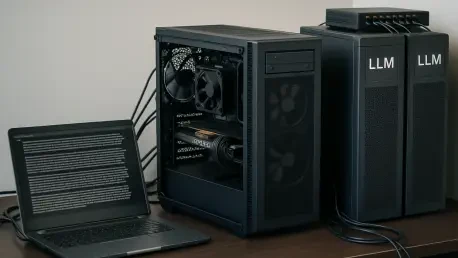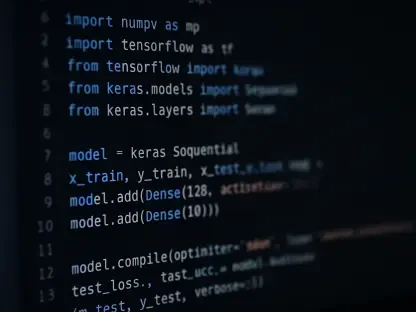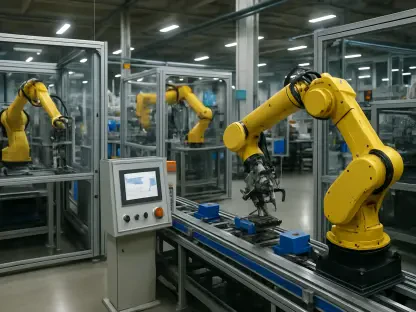In an era where large language models (LLMs) are becoming the backbone of countless applications, from chatbots to content generation, the demand for faster and more energy-efficient inference solutions has never been more pressing. These models, often comprising billions of parameters, place immense computational burdens on traditional hardware like GPUs, leading to high latency and significant power consumption. Enter a groundbreaking solution that tackles these challenges head-on by leveraging the unique capabilities of field-programmable gate arrays (FPGAs). This innovative approach reimagines how LLMs can be deployed in resource-constrained environments, offering a glimpse into a future where efficiency and performance go hand in hand. By focusing on streaming dataflows and automated optimization, this technology promises to transform the landscape of machine learning inference, making it accessible and sustainable for a wider range of applications. The following exploration delves into the intricacies of this advancement, shedding light on its potential to redefine hardware acceleration for modern AI workloads.
Redefining Inference with Streaming Dataflows
The core innovation behind this technology lies in its ability to transform the traditional inference process for LLMs into a streamlined, dataflow-centric approach on FPGAs. Unlike conventional methods that rely heavily on batched kernel execution and frequent off-chip DRAM access, this framework prioritizes on-chip streaming of intermediate data tiles. By utilizing First-In-First-Out (FIFO) buffers, it minimizes the latency typically associated with data movement to and from external memory. This shift not only enhances performance but also significantly reduces energy consumption, addressing two critical pain points in deploying LLMs at scale. The emphasis on streaming ensures that data is processed in a continuous flow, avoiding the bottlenecks that plague traditional GPU-based systems. For applications requiring real-time responses, such as interactive AI systems, this approach offers a compelling alternative that balances speed with efficiency, paving the way for broader adoption in edge and cloud environments.
Beyond the streaming paradigm, the framework introduces a novel abstraction known as the “iterative tensor” or itensor, which plays a pivotal role in ensuring seamless data handling. This abstraction encapsulates critical details such as iteration order, tiling strategies, and data layouts, making it possible to maintain compatibility between different processing kernels. By formalizing how data is structured and moved, the itensor eliminates mismatches that could disrupt the flow between producer and consumer kernels, thus enabling safe kernel fusion. This design reduces the need for frequent format conversions, further optimizing performance on FPGA hardware. Additionally, the automation of buffer synthesis and minimal converter insertion means that developers are spared from manual tuning, lowering the barrier to entry for leveraging specialized hardware. This strategic focus on dataflow integrity highlights a forward-thinking approach to tackling the complexities of LLM inference in diverse operational contexts.
Automating Optimization through Compiler Innovation
A standout feature of this technology is its end-to-end compilation pipeline, which simplifies the transition of LLMs from high-level frameworks like PyTorch to FPGA hardware. This pipeline converts models through intermediate representations such as Torch-MLIR and MLIR Linalg into a dataflow-centric format with explicit streaming constructs. By automating the generation of hardware kernels and host/runtime integration, it eliminates the need for manual coding in hardware description languages like RTL. This level of automation is a game-changer, as it reduces the expertise and time required to deploy complex models on specialized hardware. For organizations looking to capitalize on the benefits of FPGAs without investing in extensive hardware design resources, this compiler-driven approach offers a practical and scalable solution. The result is a more accessible path to achieving high-performance inference, particularly for decoding workloads that dominate many real-world LLM applications.
Equally impressive is the hierarchical design space exploration (DSE) integrated into the framework, which optimizes performance across multiple dimensions. This process carefully balances factors such as tiling, vectorization, kernel fusion, and resource allocation to achieve sustained throughput under stringent bandwidth constraints. By systematically exploring various configurations, the DSE ensures that the system adapts to the unique characteristics of each model and hardware setup. Furthermore, a linear programming approach is employed to size inter-kernel FIFOs, preventing stalls or deadlocks while minimizing the use of on-chip memory resources like BRAM and URAM. This meticulous attention to resource management underscores the framework’s ability to deliver reliable performance without wasting valuable hardware capacity. Such innovations reflect a deep understanding of the challenges inherent in FPGA-based acceleration, offering a robust foundation for deploying LLMs in latency-sensitive and power-constrained scenarios.
Performance Gains and Energy Efficiency
Benchmark results reveal the tangible benefits of this technology, showcasing its competitive edge over traditional solutions. When tested on LLM decoding tasks, the framework achieves latency reductions of up to 0.64 times compared to GPU baselines and up to 0.76 times compared to prior FPGA accelerators. These improvements translate to faster response times, which are crucial for applications where user experience hinges on immediacy. The ability to outperform established GPU systems in specific workloads demonstrates the potential of FPGAs as viable alternatives for machine learning inference. Moreover, the focus on decoding tasks aligns with the growing demand for efficient text generation and processing in AI-driven tools. For industries ranging from customer service to content creation, these performance gains could unlock new possibilities, enabling more responsive and scalable solutions that meet the needs of an increasingly digital world.
Energy efficiency stands out as another hallmark of this approach, with reported improvements of up to 1.99 times over high-end GPUs like NVIDIA’s A100, depending on the model. In an era where sustainability is a pressing concern, reducing the power footprint of compute-intensive tasks like LLM inference is a significant achievement. This efficiency stems from the minimized data movement and optimized on-chip processing enabled by the streaming dataflow design. For data centers and edge devices alike, where power consumption directly impacts operational costs and environmental impact, such advancements offer a compelling case for adopting FPGA-based solutions. The ability to deliver high performance while consuming less energy positions this technology as a forward-looking option for organizations aiming to balance innovation with responsibility. These results highlight the transformative potential of rethinking hardware acceleration for modern AI workloads.
Future Horizons for FPGA Acceleration
Reflecting on the strides made, the journey of optimizing LLM inference through streaming dataflows on FPGAs has proven to be a remarkable endeavor. The demonstrated reductions in latency and boosts in energy efficiency underscore a pivotal shift in how machine learning workloads are handled, offering a glimpse into more sustainable and responsive AI systems. These achievements, grounded in automated compilation and meticulous design exploration, set a high bar for what specialized hardware can accomplish. The focus on decoding tasks reveals a targeted yet powerful application, addressing immediate needs in real-time processing that many industries rely upon. As the benchmarks show, the ability to rival and even surpass traditional GPU performance in specific scenarios marks a significant milestone, reshaping expectations for hardware acceleration.
Looking ahead, the path forward involves expanding the scope of this technology to encompass a broader range of machine learning tasks beyond decoding, such as training or non-LLM models. Adapting the streaming principles and automated optimizations to other hardware platforms could further democratize access to high-efficiency inference solutions. Continued research into integrating these advancements with emerging FPGA architectures promises to unlock even greater potential. For stakeholders in AI deployment, exploring hybrid systems that combine the strengths of FPGAs with other accelerators might offer a balanced approach to meeting diverse workload demands. Ultimately, the lessons learned from this innovation encourage a deeper investment in dataflow-centric designs, ensuring that future AI systems are not only powerful but also sustainable and adaptable to evolving technological landscapes.









